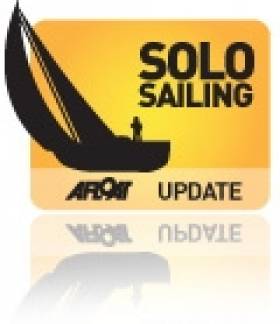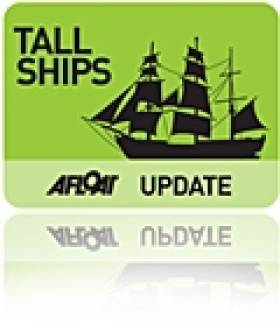Displaying items by tag: Kish Lighthouse
Marine Notice: University of Limerick ROV Trial in Irish Sea Near Kish Bank Lighthouse
Research survey TC22017 will be carried out in the Irish Sea in the vicinity of the Kish Bank Lighthouse by the University of Limerick (UL) in collaboration with the Marine Institute from this Sunday 11 to Friday 16 December, subject to weather and operational constraints.
The aim of this survey the testing and development of UL’s underwater ROV (remotely operated vehicle) system and automation platforms.
Ship-time will be focused on trialling comprehensive multi-disciplinary control and inspection methods, utilising new technologies to enable automated offshore asset inspection.
The primary outcome of the trials is to work towards the development of a framework and technique for the inspection of offshore assets remotely.
The survey will be conducted by the RV Tom Crean (callsign EIYX3) which will display appropriate lights and signals. The operations will take place between 7am and 7pm daily. The vessel will mainly run in DP mode while the ROV operates close to Kish Bank Lighthouse.
A map and coordinates of the survey area as well as contact details and a list of equipment used can be found in Marine Notice No 84 of 2022, attached below.
Workboat Hired to Assist In Replacing of Helipad at Kish Lighthouse
#Lighthouses - A workboat operating from Dun Laoghaire Harbour which was used to assist the Commissioners of Irish Lights has completed duties offshore at the Kish Lighthouse, writes Jehan Ashmore.
The Westport registered workboat, James, Afloat spotted since the summer has in recent weeks returned to Dun Laoghaire to complete the refurbishment of the Kish Bank Lighthouse, which through a public tender procurement application was contracted to Cunningham Civil & Marine.
In order to carry out refurbishment of the lighthouse exterior which involved dismantling, fabricating and erecting a new helipad, Cunningham Civil engaged the services of O'Malley Marine Plant Ltd, by hiring from the newly formed company their landing craft workboat James. The craft during the project was based out of Dun Laoghaire Harbour at the Irish Lights depot.
Afloat can also reveal the works saw the removal of the disused crane equipment from the 31m high structure. This is where lighthouse keepers worked and were accommodated until automation took over in 1992.
Cunningham Civil as consultants engaged in the project, followed a major structural review of the Kish Lighthouse in 2015 (50th anniversary, see Afloat coverage). The review found the tower to be structurally sound but made a number of recommendations among them metal fixtures such as the helipad and the crane.
The Kish Lighthouse became operational in 1965 and currently has a range of 22 nautical miles.
On completion of the installation of the tower this replaced a lightship stationed on the Kish Bank. Previous lightships can be traced back to 1811 when the first light was exhibited to provide a navigation mark to shipping using the Port of Dublin and to passing traffic.
Sunday June 9th sees the return of the popular and novel Kish lighthouse Solo/Two Handed Race on Dublin Bay aimed at both the regular Bay racers and non racers alike.
The race is run by the Dun Laoghaire Motor Yacht Club (DMYC).
The event offers a challenge of seamanship to all sailors, as well as the challenge of navigating a course to and manoeuvring around the lighthouse structure.
Last year's solo category was dominated by Ruffian sailors, with many managing to set the kite during the race. The event is open to all keelboats with an ECHO certificate, who comply with Dublin Bay Sailing Club (DBSC) safety standards.
The club will have several support craft along the route and take a cautious view on the weather conditions on the day, to ensure safety is paramount.
Entry forms and the NOR are available from the office in the DMYC on the West Pier.
Lecture: Dublin Bay and the Kish Light
#LECTURES – Pádraig Laffan will present his lecture on 'Dublin Bay and the Kish Light' next Tuesday (20th March) starting at 8pm in the Foxrock Parish Centre. The Co. Dublin venue is located at the rear of the R.C. Church.
All are welcome to the lecture (admission €3) which is part of a monthly held talks programme run by the Foxrock Local History Club. For further information visit www.foxrocklocalhistory.ie/page7.html
Giant New Car Truck Carrier Docks in Dublin
She is operated by Wallenius Wilhelmsen Lines (WWL) and was built by Daewoo Shipbuilding & Marine Engineering. The new vessel's principle dimensions are (length: 227.8m, beam: 32.26 and a draft of 11.3m) and she has a deadweight (metric tonnes) of 30,900.
The Swedish company together with subsidiaries and partner's, operates a fleet of about 135 vessels. Of these, Wallenius owns or charters around 35. They can carry up to 8,000 cars, or a combination of cars, trucks, cranes, large rolls of paper and rubber or large turbines. They have also transported parts for wind turbines, luxury yachts, complete train-sets and aircraft wings.
Figaro's docking in Dublin today was at berth 33, which is the centre berth of three lining Ocean Pier which has a quayside totalling 410m long. The pier is within Alexandra Basin and is to the east side of this dock which is approached from the port channel opposite the Poolbeg Marina.
After Dublin she continues her global schedule to Bremerhaven (16 Nov), Zeebrugge (23 Nov), Southampton (24 Nov), Baltimore, USA (3 Dec), Savannah, GA USA (6 Dec), Manzanillo, Panama (11 Dec), Auckland (29 Dec), Brisbane in the New Year (2 Jan) and two days later is expected to dock in Port Kemble also in Australia.
Earlier this year the world's largest ro-ro carrier Tonsberg (PHOTO) also part of the WWL fleet, docked in Dublin having entered service in March. She has a cargo volume of 138,000 cubic metres, some 10% greater than the largest ro-ro vessels in service including her fleetmate the Figaro.
The 74,622grt vessel is the first of four Mark V class on order from Mitsubishi Heavy Industries in Nagasaki, Japan. They are capable of handling handle high and heavy cargo such as excavators, bulldozers, wheel loaders and harvesters. Her sister Parsifal followed in September and the final pair of the quartet are due for delivery in 2012.
Courtown Harbour Rowing Club took second place in a time of 3:3:19 and third place honours went to Stella Maris Rowing Club with a time of 3:16.00. The hosts of the Hobblers Challenge, St. Michaels Rowing Club based out of the Coal Harbour, passed under the high walls of the East Pier Lighthouse and battery some two minutes later in fourth place.
The annual event (for race-route click HERE) was only re-introduced onto the race calendar last year after a break of several years. The skiffs were launched at the Coal Harbour slipway where they headed over to line-up for the starter's gun opposite the Hobbler's Memorial located on the publicly accessible Eastern Breakwater which is between the Stena Line HSS fast-ferry berth and the Dun Laoghaire Marina.
In attendance to greet the start of the race in memorial of the Dublin Bay hobblers was the RNLB Anna Livia of the local RNLI lifeboat station. The bronze memorial depicts a tower of lifejackets in commemoration of three young Dun Laoghaire hobblers who after piloting and unloading the schooner Jealous of Me in Ringsend, failed to return home.
This occupation was carried out by men also from Ringsend, Dalkey and other harbours and it was the first crew to reach a ship and throw a hook on the deck who would win the business of pilotage and unloading in Dublin Port.
Crews would think nothing of rowing out to the Kish Bank on the hope of spotting a ship. If they waited offshore and no passing trade appeared along the East Coast the craft doubled as a bed if it became too late to row home. The craft were much larger and heavier compared to the present day skiff and it is in these oarstrokes that the Hobblers Challenge follows the original race of the hobblers during the 18th and 19th centuries.
It was apt that on the same day of this year's Hobblers Challenge, the 107-year-old ketch Bessie Ellen, a former cargo-carrying vessel that represented one of the last such sail-trading ships operating in the Irish Sea, was making a passage to the east of the Kish Bank.
To read more about the un-manned Kish Lighthouse click this HERE, and for the 150 cargo tons capacity ketch built in 1904 click HERE.
- Dublin Port
- Fishing
- Dun Laoghaire Marina
- Dublin Bay News
- Irish Lights
- Dun Laoghaire Harbour
- Kish Bank
- Ferry news
- Stella Maris Rowing Club
- Kish Lighthouse
- East Coast skiffs
- Dun Laoghaire Harbour and news
- Stena Line HSS Dun Laoghaire
- Hobblers Challenge
- Dublin Bay pilots
- Rowing news
- Coal Harbour Dun Laoghaire
- St. Michaels Rowing Club
- Courtown Rowing Club
- St.Patricks Rowing Club
- Ringsend skiff clubs
Antigua On All-Island Visit
Antigua was originally a fishing boat built in 1957 at Thorne, Yorkshire but her appearance is completely different today. Gone are the fish as the vessel spent four years undergoing reconstruction for the purposes of accommodating paying-passengers. The work was completed in 1997 and this has included the provision of sixteen double cabins in luxurious surroundings.
Individual booking cruises can be made on the brigantine and her fleet-mates which are owned by the Tall Ships Company which take passengers on destinations not just in European waters but also to the Arctic.
The company also operate another brigantine the Artemis, the barque Artemis, the schooner Mare Frisium and the clipper Elizabeth. For further information about the company click here.




























































